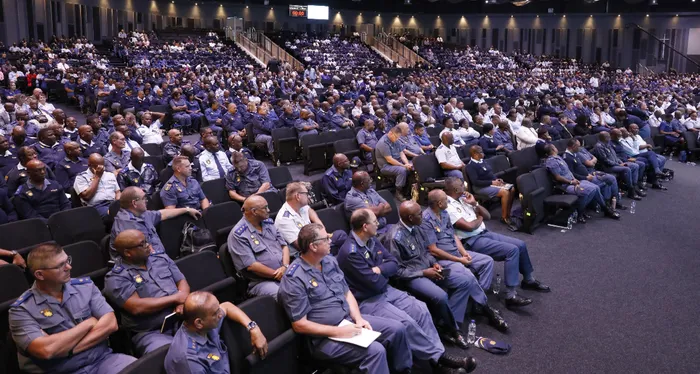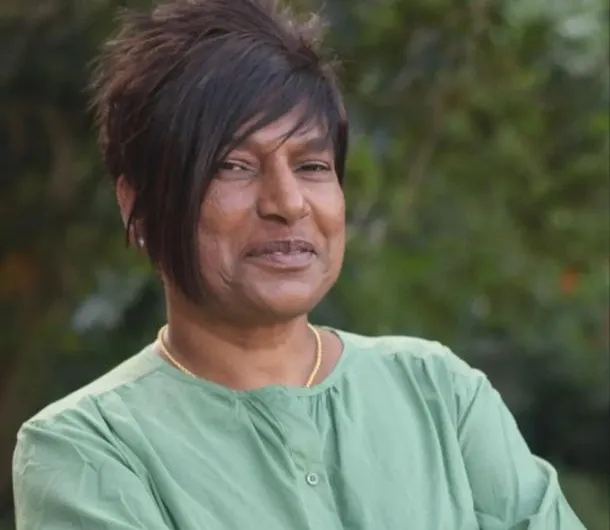Exploring notions of anti-violence for KwaZulu-Natal
A review of crime statistics over the past decade indicates that violent crime rates, in general, have been on the rise, despite multiple interventions by law enforcement and community members, says Professor Nirmala Gopal

KwaZulu-Natal police commissioner Lieutenant General Nhlanhla Mkhwanazi convened a meeting with all commanders and commissioned officers within the South African Police Service in the province on Tuesday.
Image: Doctor Ngcobo / Independent Newspapers
South Africa’s landscape of violence has regrettably escalated to alarming levels. A review of crime statistics over the past decade indicates that violent crime rates, in general, have been on the rise, despite multiple interventions by law enforcement and community members. Perhaps what we are losing sight of is the fact that the violence we observe playing itself out is a complex issue of significant scale with far-reaching socio-economic and public health consequences.
Violence is likely a primary contributor to the loss of potential and productivity among the nation’s youth. A notion that is so frequently either ignored or misunderstood. Zooming in on KwaZulu-Natal, often regarded by many as one of the most violent provinces in the country, one would observe that violent crime (category specific) is either on the increase or stable.
It’s tricky to imagine a situation that could comfort those who hold nonviolence and peace as core principles in their lives. Nonviolence has been a hallmark of an influential individual, Mahatma Gandhi, particularly in KZN. So, for individuals who profoundly cherish these values, the harsh realities of conflict and instability could feel particularly discouraging.
So why is a non-violent attitude advantageous to our communities in KZN?
Many role players might be acutely aware that the impact of violence not only disrupts lives but also undermines the ideals of harmony and understanding that they strive to cultivate in an ailing economy and a province whose social fabric has degenerated to incomprehensible levels. Therefore, it stands to reason that any scenario that seeks to comfort them must address the complex emotions tied to loss and suffering.
How often do we stop and reflect on the global rather than individual impact? Often, our narrow, inward-looking needs detract from the notion of community needs and the impact of our conflicts that escalate into violence in one form or another. Additionally, the lack of altruism in our individual constitution is unhelpful in our goal to use public resources more effectively, where the need is dire.
Additionally, pro-violent attitudes are fertile grounds for the recreation of violent attitudes and behaviours to resolve even minor conflicts. This notion is undergirded by research that overwhelmingly demonstrates that family experiences significantly influence the development of violent behaviours in children and adolescents.
Research further confirms that violence is often understood as learned behaviour, specifically regarding children’s early life experiences, which contribute to young people procuring values, attitudes, and interpersonal skills, thus contributing to the development of violent behaviour.
Is this the community we want to foster, or do we want to desist from inadvertently sustaining the pro-violent culture? Are we even aware of the long-lasting impact of our personal conflicts on the children and young people in our province?
Drawing on numerous existing data sources that highlight the causes and prevalence of violent behaviour in KZN, particularly in Chatsworth, it may be more effective to clearly define how the current situation affects the broader KZN community and its initiatives aimed at resolving crime, ultimately striving to make KZN a safer environment.
It’s important to approach the analysis of violence with a broad perspective, beginning at the individual level, then moving on to the community level. Building upon the necessity for anti-violence in KZN, a province grappling with the complexities of conflict, it becomes evident that fostering non-violent resolutions necessitates a multifaceted approach.
Several key strategies emerge as potentially advantageous in cultivating more peaceful and harmonious communities. One such cornerstone lies in dialogue and communication. Indeed, scholarly inquiry suggests that effective communication forms the bedrock of numerous non-violent conflict management methodologies. Whether through collaborative endeavours, nuanced negotiation, open dialogue, or the facilitative interventions of impartial third parties such as in mediation, the ability to articulate, listen, and understand stands as a non-adversarial and remarkably cost-effective means of both pre-empting and resolving disputes.
Conversely, the erosion of communicative channels invariably risks an escalation of tensions, rendering the path to resolution considerably more difficult. Therefore, the cultivation and maintenance of open avenues for dialogue represent an invaluable asset in both preventing and addressing conflicts within communities striving for stability.
Furthermore, the practice of mediation offers a widely recognised and adaptable tool in the realm of conflict resolution. While traditionally conceived as an interest-based negotiation process guided by a neutral third party, contemporary understandings increasingly emphasise "process-based" mediation. This evolved model prioritises the quality of relational interaction and the inclusive participation of the community, extending beyond the mere attainment of a settlement.
Notably effective within African contexts, this approach focuses on the transformation of relationships and the crucial task of addressing the fundamental causes of conflict through processes that are sensitive to the specific context, the involvement of insider mediators who possess cultural understanding, and a strong emphasis on relational dynamics.
Such mediation practices have demonstrated their potential to nurture enduring peace and foster reconciliation at the vital community level. Conflict resolution training emerges as a vital component in equipping communities with the practical means to navigate disputes non-violently. These programs often weave together theoretical understanding with hands-on experience, imparting essential skills in communication, negotiation, and mediation techniques.
By empowering individuals with the capacity to engage in challenging conversations constructively, such training fosters a culture of effective communication and bolsters the community’s overall ability to resolve conflicts in a non-violent manner. Moreover, specialised workshops can be thoughtfully tailored to address the specific needs and contexts of diverse groups within the community, including community leaders, law enforcement officials, and the youth, thereby targeting particular conflict scenarios with relevant skills.
At the grassroots level, the formation of community peace committees represents a powerful embodiment of local agency and resilience. These initiatives, organically arising from local residents, serve as collaborative platforms for addressing and resolving disputes within the community. By enabling communities to unite, actively participate, and co-design peacebuilding processes, these committees foster a sense of ownership and shared responsibility.
Research insights highlight the capacity of such informal peace committees to promote empowerment, self-reliance, and developmental social work. The inclusive involvement of diverse community members in the planning and decision-making processes inherent in peace committees builds crucial capacity for sustainable conflict resolution and overall community development.
The very fabric of society, woven with cultural and traditional practices, significantly shapes approaches to conflict resolution. Many communities possess time-honoured traditions that utilise mediation and negotiation as peaceful means of settling disputes, deeply rooted in cultural values that prioritise reconciliation and communal harmony. Traditional mediators, often respected figures within the community, play a vital role in facilitating dialogue and guiding conflicting parties toward common ground.
These practices hold particular efficacy when thoughtfully adapted to contemporary settings, providing culturally relevant and trusted frameworks for resolving disputes in a manner that resonates with community values. Recognising the pivotal role of younger generations, youth engagement programs stand as a critical component of community conflict resolution. Involving young people in mediation and dialogue initiatives not only directly addresses disputes that affect them, such as those within school environments, but also cultivates essential leadership skills and a sense of responsibility.
The active participation of youth in peacebuilding efforts strengthens the resilience of the community as a whole and ensures that the perspectives and needs of younger generations are meaningfully integrated into conflict resolution strategies. Furthermore, the establishment of clear community agreements and norms provides a shared framework for acceptable behaviour and conflict management within a community. These agreements, developed through collaborative processes, set clear expectations regarding communication styles, mutual respect, and problem-solving approaches.
When conflicts inevitably arise, community members can refer to these collectively established norms to guide their responses, thereby reducing ambiguity and fostering consistent, non-violent resolution practices. Finally, the mastery of de-escalation techniques is essential for preventing conflicts from escalating into overt violence.
These crucial strategies encompass active listening, the maintenance of calm and neutral body language, the acknowledgement of expressed emotions, and the careful use of neutral language aimed at reducing tension in volatile situations. Equipping community members with training in de-escalation skills empowers them to intervene constructively in heated moments, effectively creating space for dialogue and the pursuit of peaceful resolution.
These multifaceted strategies, ranging from fostering open communication and utilising effective mediation practices to empowering communities through training and grassroots initiatives, and drawing upon the wisdom of cultural traditions while actively engaging youth, offer a comprehensive pathway towards cultivating a more non-violent landscape within KwaZulu-Natal.
By embracing these approaches, communities can strive to mitigate the detrimental impacts of violence and foster a more harmonious and resilient social fabric. Notably, teach community members that their behaviour will influence future crime and violence patterns in their communities and work counter to their ideals of a crime and violence-free province for their children and grandchildren.
Making our province safe and using law enforcement resources effectively begins with every one of us. Communities must stop and reconsider why we escalate minor issues to the level of law enforcement. Why are we not neighbourly any longer? What, where and when did we lose our sense of neighbourliness?

Professor Nirmala Gopal
Image: Supplied
Professor Nirmala Gopal is an academic leader: School of Applied Human Science at the University of KwaZulu-Natal.
** The views expressed do not necessarily reflect the views of IOL or Independent Media.
Related Topics: